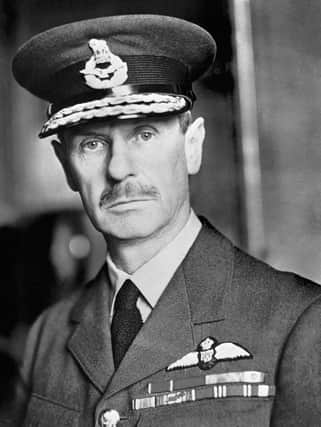The Moffat airman who led victory at the Battle of Britain


Every year, the town of Moffat falls still as a fly past scores the sky in memory of the man who led victory at the Battle of Britain.
Here, Air Chief Marshall Hugh Dowding (1882 – 1970) Commander in Chief of Fighter Command, is still remembered as one of the few owed so much by so many.
Advertisement
Hide AdAdvertisement
Hide AdNicknamed Stuffy because of his seemingly aloof and difficult ways, Dowding was described as the "architect of deliverance" following the campaign to defeat the attacking Luftwaffe with squadrons of Hawker Hurricanes and Supermarine Spitfires which the airman had pushed to secure.
Dowding's support for the development of the first experimental RADAR (then known as RDF) stations on the coast was also critical to the victory - as was the creation of the Dowding System, the first integrated defence system of its type.
“Mine was the purely defensive role of trying to stop the possibility of an invasion, and thus giving the country a breathing spell … it was Germany’s objective to win the war by invasion, and it was my job to prevent such an invasion from taking place," he later said, perhaps in true Stuffy style.
Yet, despite the victory, within three months of the Luftwaffe being forced to retreat, a group of colleagues conspired to oust him from his post with RAF politics finally toppling his armed forces career. His later life was defined by spiritualism and animal rights, and perhaps a bitterness at the way he felt he was treated by the RAF.
Dowding was born in 1882 at the St Ninian's Boy's Preparatory School in Moffat. He later attended the school his father had founded before joining Winchester College and then the Royal Military Academy in Woolwich.
He signed up to the Army on a scholarship and took flying lessons before being accepted by the Royal Flying Corps.
Dowding's father demanded he stop ''this ridiculous flying'' but it was too late. The RFC said it could not accept his resignation since the 1914 war had just begun.
By 1918, the airman had been promoted to Brigadier General but he clashed with his superiors over the need for rest for pilots exhausted by constant flying sorties.
Advertisement
Hide AdAdvertisement
Hide AdAs a result, Dowding was sent back to Britain and he took no more active part in World War One.
With fears that Germany was secretly rebuilding air capacity following the end of the conflict, Dowding was appointed head of training with his work partly focusing on solving problems raised by conflicts in the Middle East.
In 1936 he was Appointed Commander-in-Chief of RAF Fighter Commad and Air Chief Marshall the following year. Dowding was to spearhead the development of the air defence network, dubbed the Dowding System, that was to bring together technology, ground defences and fighter aircraft into a unified system for the first time.
As World War 2 broke out, Dowding agreed to postpone his retirement - with the Dowding System to give the RAF a critical advantage during the Battle of Britain.
Dowding, however, faced his own hostile forces.
When Churchill ordered more Hurricanes to be sent to France in the days before the withdrawal at Dunkirk, Dowding refused, claiming it would leave home defences vulnerable. He later claimed Churchill had never liked him much after that - if he had liked him at all.
The airman was also to resist demands from for a Big Wing strategy to meet incoming Luftwaffe bombing raids with a wing-sized formation of three to five squadrons.
Dowding argued they were a drain on resources and too difficult to assemble with airmen likely to drown in the Channel if they were shot down.
But the advocates of the tactic, some close friends and admired colleagues, were to secure Dowding's own downfall over the row at at a time when public and political pressure mounted over the onslaught of The Blitz.
Advertisement
Hide AdAdvertisement
Hide AdDowding was replaced following a short phonecall asking him to leave his desk on November 25, 1940. His successor was William Sholto-Douglas, an advocate of more aggressive air tactics who Dowding had earlier saved from a court marshall.
Dowding, who was made a Knight Grand Cross of the Order of the Bath before his departure, was dispatched to the US to rally support for the war effort.
He retired from the RAF in 1942. His belief he had been unjustly treated by the RAF followed him into later life which he dedicated to spiritualism - he claimed he had spoken several times to the spirits of dead airmen - vegetarianism and the anti-vivisection movement.
He died in 1970 with his ashes left below the Battle of Britain memorial window in the Royal Air Force chapel at Westminster Abbey.
While his role in the defence of Great Britain may have been lost at times, Historian AJP Taylor later claimed Dowding won the "decisive battle of the war" with the victory as "glorious in our history as the Battle of Trafalgar".
In Moffat, too, Dowding has never been forgotten.